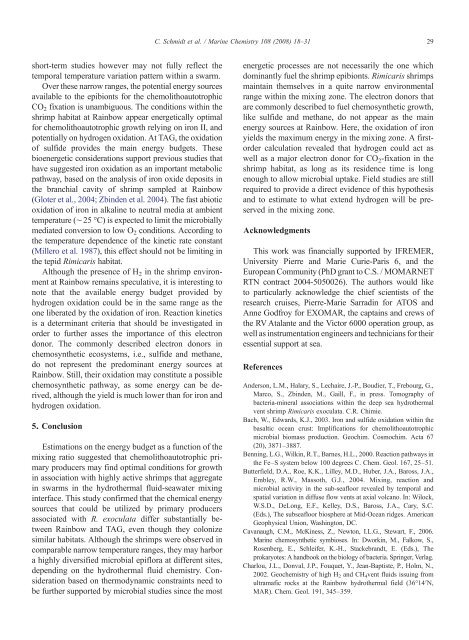Geochemical energy sources for microbial primary production in the ...
Geochemical energy sources for microbial primary production in the ...
Geochemical energy sources for microbial primary production in the ...
Create successful ePaper yourself
Turn your PDF publications into a flip-book with our unique Google optimized e-Paper software.
C. Schmidt et al. / Mar<strong>in</strong>e Chemistry 108 (2008) 18–31<br />
29<br />
short-term studies however may not fully reflect <strong>the</strong><br />
temporal temperature variation pattern with<strong>in</strong> a swarm.<br />
Over <strong>the</strong>se narrow ranges, <strong>the</strong> potential <strong>energy</strong> <strong>sources</strong><br />
available to <strong>the</strong> epibionts <strong>for</strong> <strong>the</strong> chemolithoautotrophic<br />
CO 2 fixation is unambiguous. The conditions with<strong>in</strong> <strong>the</strong><br />
shrimp habitat at Ra<strong>in</strong>bow appear energetically optimal<br />
<strong>for</strong> chemolithoautotrophic growth rely<strong>in</strong>g on iron II, and<br />
potentially on hydrogen oxidation. At TAG, <strong>the</strong> oxidation<br />
of sulfide provides <strong>the</strong> ma<strong>in</strong> <strong>energy</strong> budgets. These<br />
bioenergetic considerations support previous studies that<br />
have suggested iron oxidation as an important metabolic<br />
pathway, based on <strong>the</strong> analysis of iron oxide deposits <strong>in</strong><br />
<strong>the</strong> branchial cavity of shrimp sampled at Ra<strong>in</strong>bow<br />
(Gloter et al., 2004; Zb<strong>in</strong>den et al. 2004). The fast abiotic<br />
oxidation of iron <strong>in</strong> alkal<strong>in</strong>e to neutral media at ambient<br />
temperature (∼25 °C) is expected to limit <strong>the</strong> <strong>microbial</strong>ly<br />
mediated conversion to low O 2 conditions. Accord<strong>in</strong>g to<br />
<strong>the</strong> temperature dependence of <strong>the</strong> k<strong>in</strong>etic rate constant<br />
(Millero et al. 1987), this effect should not be limit<strong>in</strong>g <strong>in</strong><br />
<strong>the</strong> tepid Rimicaris habitat.<br />
Although <strong>the</strong> presence of H 2 <strong>in</strong> <strong>the</strong> shrimp environment<br />
at Ra<strong>in</strong>bow rema<strong>in</strong>s speculative, it is <strong>in</strong>terest<strong>in</strong>g to<br />
note that <strong>the</strong> available <strong>energy</strong> budget provided by<br />
hydrogen oxidation could be <strong>in</strong> <strong>the</strong> same range as <strong>the</strong><br />
one liberated by <strong>the</strong> oxidation of iron. Reaction k<strong>in</strong>etics<br />
is a determ<strong>in</strong>ant criteria that should be <strong>in</strong>vestigated <strong>in</strong><br />
order to fur<strong>the</strong>r asses <strong>the</strong> importance of this electron<br />
donor. The commonly described electron donors <strong>in</strong><br />
chemosyn<strong>the</strong>tic ecosystems, i.e., sulfide and methane,<br />
do not represent <strong>the</strong> predom<strong>in</strong>ant <strong>energy</strong> <strong>sources</strong> at<br />
Ra<strong>in</strong>bow. Still, <strong>the</strong>ir oxidation may constitute a possible<br />
chemosyn<strong>the</strong>tic pathway, as some <strong>energy</strong> can be derived,<br />
although <strong>the</strong> yield is much lower than <strong>for</strong> iron and<br />
hydrogen oxidation.<br />
5. Conclusion<br />
Estimations on <strong>the</strong> <strong>energy</strong> budget as a function of <strong>the</strong><br />
mix<strong>in</strong>g ratio suggested that chemolithoautotrophic <strong>primary</strong><br />
producers may f<strong>in</strong>d optimal conditions <strong>for</strong> growth<br />
<strong>in</strong> association with highly active shrimps that aggregate<br />
<strong>in</strong> swarms <strong>in</strong> <strong>the</strong> hydro<strong>the</strong>rmal fluid-seawater mix<strong>in</strong>g<br />
<strong>in</strong>terface. This study confirmed that <strong>the</strong> chemical <strong>energy</strong><br />
<strong>sources</strong> that could be utilized by <strong>primary</strong> producers<br />
associated with R. exoculata differ substantially between<br />
Ra<strong>in</strong>bow and TAG, even though <strong>the</strong>y colonize<br />
similar habitats. Although <strong>the</strong> shrimps were observed <strong>in</strong><br />
comparable narrow temperature ranges, <strong>the</strong>y may harbor<br />
a highly diversified <strong>microbial</strong> epiflora at different sites,<br />
depend<strong>in</strong>g on <strong>the</strong> hydro<strong>the</strong>rmal fluid chemistry. Consideration<br />
based on <strong>the</strong>rmodynamic constra<strong>in</strong>ts need to<br />
be fur<strong>the</strong>r supported by <strong>microbial</strong> studies s<strong>in</strong>ce <strong>the</strong> most<br />
energetic processes are not necessarily <strong>the</strong> one which<br />
dom<strong>in</strong>antly fuel <strong>the</strong> shrimp epibionts. Rimicaris shrimps<br />
ma<strong>in</strong>ta<strong>in</strong> <strong>the</strong>mselves <strong>in</strong> a quite narrow environmental<br />
range with<strong>in</strong> <strong>the</strong> mix<strong>in</strong>g zone. The electron donors that<br />
are commonly described to fuel chemosyn<strong>the</strong>tic growth,<br />
like sulfide and methane, do not appear as <strong>the</strong> ma<strong>in</strong><br />
<strong>energy</strong> <strong>sources</strong> at Ra<strong>in</strong>bow. Here, <strong>the</strong> oxidation of iron<br />
yields <strong>the</strong> maximum <strong>energy</strong> <strong>in</strong> <strong>the</strong> mix<strong>in</strong>g zone. A firstorder<br />
calculation revealed that hydrogen could act as<br />
well as a major electron donor <strong>for</strong> CO 2 -fixation <strong>in</strong> <strong>the</strong><br />
shrimp habitat, as long as its residence time is long<br />
enough to allow <strong>microbial</strong> uptake. Field studies are still<br />
required to provide a direct evidence of this hypo<strong>the</strong>sis<br />
and to estimate to what extend hydrogen will be preserved<br />
<strong>in</strong> <strong>the</strong> mix<strong>in</strong>g zone.<br />
Acknowledgments<br />
This work was f<strong>in</strong>ancially supported by IFREMER,<br />
University Pierre and Marie Curie-Paris 6, and <strong>the</strong><br />
European Community (PhD grant to C.S. / MOMARNET<br />
RTN contract 2004-5050026). The authors would like<br />
to particularly acknowledge <strong>the</strong> chief scientists of <strong>the</strong><br />
research cruises, Pierre-Marie Sarrad<strong>in</strong> <strong>for</strong> ATOS and<br />
Anne Godfroy <strong>for</strong> EXOMAR, <strong>the</strong> capta<strong>in</strong>s and crews of<br />
<strong>the</strong> RV Atalante and <strong>the</strong> Victor 6000 operation group, as<br />
well as <strong>in</strong>strumentation eng<strong>in</strong>eers and technicians <strong>for</strong> <strong>the</strong>ir<br />
essential support at sea.<br />
References<br />
Anderson, L.M., Halary, S., Lechaire, J.-P., Boudier, T., Frebourg, G.,<br />
Marco, S., Zb<strong>in</strong>den, M., Gaill, F., <strong>in</strong> press. Tomography of<br />
bacteria-m<strong>in</strong>eral associations with<strong>in</strong> <strong>the</strong> deep sea hydro<strong>the</strong>rmal<br />
vent shrimp Rimicaris exoculata. C.R. Chimie.<br />
Bach, W., Edwards, K.J., 2003. Iron and sulfide oxidation with<strong>in</strong> <strong>the</strong><br />
basaltic ocean crust: Implifications <strong>for</strong> chemolithoautotrophic<br />
<strong>microbial</strong> biomass <strong>production</strong>. Geochim. Cosmochim. Acta 67<br />
(20), 3871–3887.<br />
Benn<strong>in</strong>g, L.G., Wilk<strong>in</strong>, R.T., Barnes, H.L., 2000. Reaction pathways <strong>in</strong><br />
<strong>the</strong> Fe–S system below 100 degrees C. Chem. Geol. 167, 25–51.<br />
Butterfield, D.A., Roe, K.K., Lilley, M.D., Huber, J.A., Baross, J.A.,<br />
Embley, R.W., Massoth, G.J., 2004. Mix<strong>in</strong>g, reaction and<br />
<strong>microbial</strong> activiry <strong>in</strong> <strong>the</strong> sub-seafloor revealed by temporal and<br />
spatial variation <strong>in</strong> diffuse flow vents at axial volcano. In: Wilock,<br />
W.S.D., DeLong, E.F., Kelley, D.S., Baross, J.A., Cary, S.C.<br />
(Eds.), The subseafloor biosphere at Mid-Ocean ridges. American<br />
Geophysical Union, Wash<strong>in</strong>gton, DC.<br />
Cavanaugh, C.M., McK<strong>in</strong>ess, Z., Newton, I.L.G., Stewart, F., 2006.<br />
Mar<strong>in</strong>e chemosyn<strong>the</strong>tic symbioses. In: Dwork<strong>in</strong>, M., Falkow, S.,<br />
Rosenberg, E., Schleifer, K.-H., Stackebrandt, E. (Eds.), The<br />
prokaryotes: A handbook on <strong>the</strong> biology of bacteria. Spr<strong>in</strong>ger, Verlag.<br />
Charlou, J.L., Donval, J.P., Fouquet, Y., Jean-Baptiste, P., Holm, N.,<br />
2002. Geochemistry of high H 2 and CH 4 vent fluids issu<strong>in</strong>g from<br />
ultramafic rocks at <strong>the</strong> Ra<strong>in</strong>bow hydro<strong>the</strong>rmal field (36°14′N,<br />
MAR). Chem. Geol. 191, 345–359.
















